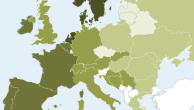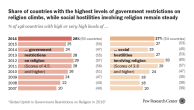This chapter looks at the size and projected growth of the world’s major religious groups from 2010-2050 in six regions of the world. The regions are presented in alphabetical order: Asia and the Pacific, Europe, Latin America and the Caribbean, the Middle East and North Africa, North America and sub-Saharan Africa.
Each section begins with an overview of the projected changes in the size of religious groups in that region. Where appropriate, the sections highlight the situation in countries of special interest. The sections also examine the demographic factors that are influencing the growth of religious groups in various regions, including fertility, age structure, religious switching and migration. (For information on life expectancy by region, see Chapter 1.)




